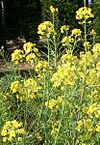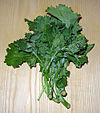Brassica rapa: Difference between revisions
m WP:CHECKWIKI error fix. Section heading problem. Violates WP:MOSHEAD. |
No edit summary |
||
| Line 15: | Line 15: | ||
'''''Brassica rapa''''' L. is a [[plant]] consisting of various widely cultivated subspecies including the [[turnip]] (a [[root vegetable]]); [[napa cabbage]], [[bomdong]], [[bok choy]], and [[Rapini|cime di rapa]] ([[leaf vegetable]]s) and (''Brassica rapa'' subsp. ''oleifera'', an [[oilseed]] which has many common names, including '''field mustard''', '''bird rape''', '''keblock''', and '''colza''').<ref name=USDA>{{cite web|title=Brassica rapa L. subsp. oleifera (DC.) Metzg.|url=http://www.ars-grin.gov/cgi-bin/npgs/html/taxon.pl?319648|work=GRIN Taxonomy for Plants|publisher=Germplasm Resources Information Network|accessdate=13 April 2013}}</ref><ref name=EOL>{{cite web|title=Brassica rapa subsp. oleifera|url=http://eol.org/pages/10451733/overview|work=Turnip Rape|publisher=EOL|accessdate=13 April 2013}}</ref><ref>{{cite book |publisher=Cambridge |location=Cambridge |year=1997 |title=New Flora of the British Isles|author=Clive Stace|authorlink = Clive A. Stace|ISBN=978-0-521-58935-2}}</ref><ref>{{cite book |title=Bailey's Dictionary |edition=5th reprint|year=1731}}</ref><ref>{{cite book |author=Doreathea Hurst |title=History and Antiquities Of Horsham |publisher=Farncombe & Co |year=1889}}</ref><ref>{{cite web|url=http://www.cas.vanderbilt.edu/bioimages/species/brra.htm |title=Brassica rapa |work=Bioimages|publisher=cas.vanderbilt.edu |date=2011 |accessdate=2010-06-10}}</ref> ''Brassica rapa'' is also known as Wisconsin Fast Plants.<ref>{{Cite web|url=https://fastplants.org/|title=Wisconsin Fast Plants of the University of Wisconsin: Homepage|website=Wisconsin Fast Plants®|language=en-US|access-date=2017-04-14}}</ref> |
'''''Brassica rapa''''' L. is a [[plant]] consisting of various widely cultivated subspecies including the [[turnip]] (a [[root vegetable]]); [[napa cabbage]], [[bomdong]], [[bok choy]], and [[Rapini|cime di rapa]] ([[leaf vegetable]]s) and (''Brassica rapa'' subsp. ''oleifera'', an [[oilseed]] which has many common names, including '''field mustard''', '''bird rape''', '''keblock''', and '''colza''').<ref name=USDA>{{cite web|title=Brassica rapa L. subsp. oleifera (DC.) Metzg.|url=http://www.ars-grin.gov/cgi-bin/npgs/html/taxon.pl?319648|work=GRIN Taxonomy for Plants|publisher=Germplasm Resources Information Network|accessdate=13 April 2013}}</ref><ref name=EOL>{{cite web|title=Brassica rapa subsp. oleifera|url=http://eol.org/pages/10451733/overview|work=Turnip Rape|publisher=EOL|accessdate=13 April 2013}}</ref><ref>{{cite book |publisher=Cambridge |location=Cambridge |year=1997 |title=New Flora of the British Isles|author=Clive Stace|authorlink = Clive A. Stace|ISBN=978-0-521-58935-2}}</ref><ref>{{cite book |title=Bailey's Dictionary |edition=5th reprint|year=1731}}</ref><ref>{{cite book |author=Doreathea Hurst |title=History and Antiquities Of Horsham |publisher=Farncombe & Co |year=1889}}</ref><ref>{{cite web|url=http://www.cas.vanderbilt.edu/bioimages/species/brra.htm |title=Brassica rapa |work=Bioimages|publisher=cas.vanderbilt.edu |date=2011 |accessdate=2010-06-10}}</ref> ''Brassica rapa'' is also known as Wisconsin Fast Plants.<ref>{{Cite web|url=https://fastplants.org/|title=Wisconsin Fast Plants of the University of Wisconsin: Homepage|website=Wisconsin Fast Plants®|language=en-US|access-date=2017-04-14}}</ref> |
||
The oil made from the seed is sometimes also called ''canola'',<ref name=USDA /> which is one reason why it is sometimes confused with [[rapeseed]] oil, but this comes from a different ''Brassica'' species (''[[Brassica napus]]''). The oilseeds known as [[canola]] are sometimes particular varieties of ''Brassica rapa'' (termed Polish Canola) but usually the related species ''Brassica napus'' (rapeseed) and ''[[Brassica juncea]]'' (mustard greens and [[mizuna]],).<ref>{{cite web|title=Chapter 2 – Canola Varieties|url=http://www.canolacouncil.org/crop-production/canola-grower%27s-manual-contents/chapter-2-canola-varieties/|work=Canola Grower's Manual|publisher=Canada Council of Canada|accessdate=1 May 2014}}</ref> |
The oil made from the seed is sometimes also called ''canola'',<ref name=USDA /> which is one reason why it is sometimes confused with [[rapeseed]] oil, but this comes from a different ''Brassica'' species (''[[Brassica napus]]''). The oilseeds known as [[canola]] are sometimes particular varieties of ''Brassica rapa'' (termed Polish Canola) but usually the related species ''[[Brassica napus]]'' (rapeseed) and ''[[Brassica juncea]]'' (mustard greens and [[mizuna]],).<ref>{{cite web|title=Chapter 2 – Canola Varieties|url=http://www.canolacouncil.org/crop-production/canola-grower%27s-manual-contents/chapter-2-canola-varieties/|work=Canola Grower's Manual|publisher=Canada Council of Canada|accessdate=1 May 2014}}</ref> |
||
== History == |
== History == |
||
Revision as of 07:54, 24 April 2017
| Brassica rapa | |
|---|---|

| |
| Scientific classification | |
| Kingdom: | |
| (unranked): | |
| (unranked): | |
| (unranked): | |
| Order: | |
| Family: | |
| Genus: | |
| Species: | B. rapa
|
| Binomial name | |
| Brassica rapa | |
Brassica rapa L. is a plant consisting of various widely cultivated subspecies including the turnip (a root vegetable); napa cabbage, bomdong, bok choy, and cime di rapa (leaf vegetables) and (Brassica rapa subsp. oleifera, an oilseed which has many common names, including field mustard, bird rape, keblock, and colza).[1][2][3][4][5][6] Brassica rapa is also known as Wisconsin Fast Plants.[7]
The oil made from the seed is sometimes also called canola,[1] which is one reason why it is sometimes confused with rapeseed oil, but this comes from a different Brassica species (Brassica napus). The oilseeds known as canola are sometimes particular varieties of Brassica rapa (termed Polish Canola) but usually the related species Brassica napus (rapeseed) and Brassica juncea (mustard greens and mizuna,).[8]
History
In the 18th century the turnip and the oilseed-producing variants were seen as being different species by Carl Linnaeus who named them B. rapa and B. campestris. 20th-century taxonomists found that the plants were cross fertile and thus belonged to the same species. Since the turnip had been named first by Linnaeus, the name Brassica rapa was adopted.[9]
Many butterflies, including the small white pollinate the B. rapa flowers.
Cultivars
| Cultivar | Image | Name |
|---|---|---|
| Bok choy |  |
Brassica rapa subsp. chinensis |
| Bomdong |  |
Brassica rapa var. glabra |
| Choy sum |  |
Brassica rapa subsp. parachinensis |
| Field Mustard |  |
Brassica rapa subsp. oleifera |
| Komatsuna |  |
Brassica rapa subsp. perviridis |
| Napa cabbage |  |
Brassica rapa subsp. pekinensis |
| Rapini |  |
Brassica rapa var. rapifera |
| Tatsoi |  |
Brassica rapa subsp. narinosa |
| Turnip |  |
Brassica rapa subsp. rapa |
| Yellow Sarson |  |
Brassica rapa subsp. trilocularis |
References
- ^ a b "Brassica rapa L. subsp. oleifera (DC.) Metzg". GRIN Taxonomy for Plants. Germplasm Resources Information Network. Retrieved 13 April 2013.
- ^ "Brassica rapa subsp. oleifera". Turnip Rape. EOL. Retrieved 13 April 2013.
- ^ Clive Stace (1997). New Flora of the British Isles. Cambridge: Cambridge. ISBN 978-0-521-58935-2.
- ^ Bailey's Dictionary (5th reprint ed.). 1731.
- ^ Doreathea Hurst (1889). History and Antiquities Of Horsham. Farncombe & Co.
- ^ "Brassica rapa". Bioimages. cas.vanderbilt.edu. 2011. Retrieved 10 June 2010.
- ^ "Wisconsin Fast Plants of the University of Wisconsin: Homepage". Wisconsin Fast Plants®. Retrieved 14 April 2017.
- ^ "Chapter 2 – Canola Varieties". Canola Grower's Manual. Canada Council of Canada. Retrieved 1 May 2014.
- ^ Phil Thomas, ed. (2003). "Canola Varieties". Canola Growers Manual. Canola Council of Canada.[dead link]
External links
 Media related to Brassica rapa at Wikimedia Commons
Media related to Brassica rapa at Wikimedia Commons- " Multilingual taxonomic information". University of Melbourne.
- PROTA (Plant Resources of Tropical Africa) database record on Brassica rapa L.
- "Brassica rapa". Integrated Taxonomic Information System. Retrieved 17 November 2006.
- "Brassica rapa 'L". Germplasm Resources Information Network. Agricultural Research Service, United States Department of Agriculture. Retrieved 28 August 2013.
